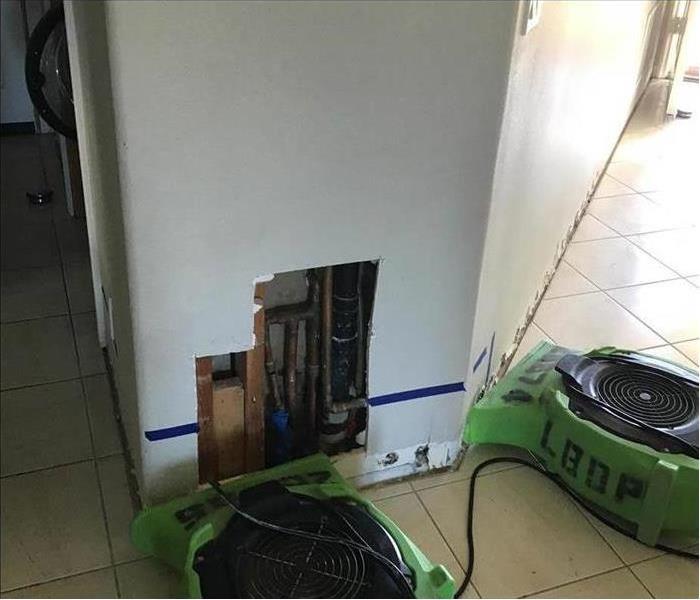Can I Do my Own Home Water Damage Restoration?
1/9/2023 (Permalink)
Can I Do my Own Home Water Damage Restoration?
Water damage is a serious problem that can have long-lasting effects on your Anaheim, CA home. If you don't properly clean up the water and dry out your possessions, mold and mildew can start growing. Not only does this make the house smell bad, but it also increases the risk of serious property damage.
The Water Damage Restoration Process
The water damage restoration process is a lot more complicated than you think. However, this doesn't mean that you can't do your own home water damage restoration.
First, you need to make sure that the area is safe for yourself and others in your house. If there's any chance of electrocution or toxic fumes, it's best not to attempt it yourself.
Once this has been decided on, start removing all of the furniture from the room that has been damaged by water. Next up is drying out the area so it won't be damaged further by mold or mildew growths or wood rot caused by excess moisture buildup (which could lead to structural problems later on).
When choosing between professional help vs DIY solutions for repairs and cleanup after flooding events at home--do your research! There are pros & cons-but most importantly remember: safety first!!
Step 1: Assess Safety
Before you begin, it is important to assess the safety of the area. Make sure that there are no electrical hazards, gas leaks or structural damage in your home. If mold has started growing on any surfaces, you will want to wear protective gear and use fans to blow air out of your house as much as possible until a professional water damage restoration company can come in and help get rid of it.
Step 2: Remove any Standing Water
Now that you’ve removed any visible water, it’s time to get a little more serious. If your home was flooded by an overflowing toilet, sink or tub, use a wet vacuum (or rent one) to suck up the standing water where it has pooled. If the source of the flood is not obvious—perhaps there was a pipe leak behind walls or under floors—use a mop or sponge to soak up as much water as possible from carpets and furniture before going further with this next step. For any area where standing water still remains after soaking for several minutes with towels or rags, choose another towel or rag and wring some more out until most of the excess moisture has been wrung out of it. Repeat this process until only dry towels remain. Only when both rooms are completely dry should you proceed to Step 3.
Step 3: Protect your possessions
- Dehumidifiers and moisture control. These are two of the most important things you can do to protect your possessions from water damage. A dehumidifier will remove any excess moisture from the air, preventing it from settling on your furniture and household items. The ideal humidity level for a room is 50 percent, which is especially important during winter months when heating systems dry out homes that are already low in moisture.
- Air conditioning and ventilation. Your air conditioner should be set at 78 degrees Fahrenheit with 50% relative humidity to prevent mold growth or further water damage behind walls and ceilings. If there's no AC system in place already, consider installing one before disaster strikes!
- Water damage restoration services (if needed). Homeowners often try home remedies like sponging up spills with paper towels or mopping them away with soap-and-water mixtures—but these aren't always effective ways of dealing with larger amounts of water than just a few drops here or there on hardwood floors or carpets; they also risk spreading bacteria throughout other areas of your house rather than containing it within one localized area so that professionals can clean up properly afterward without worrying about cross-contamination between rooms/floors etc.
Step 4: Dry the Affected Areas
Once all the water has been removed, it's important to dry out all affected areas.
- Use fans to help remove moisture from the air and circulate air in your Anaheim, CA home.
- Use dehumidifiers or a wet vac to remove excess water from hard surfaces and carpets.
- If you have central air conditioning or heating systems, turn them on for a few hours each day until all areas are completely dry.
DIY Water Damage Restoration
Water damage repair is a dangerous process and can be time-consuming. However, it's also important to recognize that some homeowners have the skills and knowledge necessary to successfully complete their own home water damage restoration without professional assistance.
If you have the experience and training required for successful DIY water damage repair, we highly recommend reading through our guide on how to do it yourself!
Don't be afraid to ask for help if you're not sure how to handle a water damage emergency. Water damage repair can be complicated, and it's best to leave the job to professionals who have experience with the process. If you are overwhelmed by the amount of work that needs done after a flood or other emergency like pipe bursting, then contact us today! We will assess your situation and give you an estimate within 24 hours.






 24/7 Emergency Service
24/7 Emergency Service
